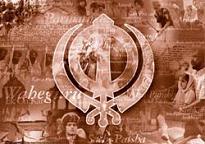
 |
Sikh Missionary Society
U.K. (Regd)
10,
Featherstone Road.
Southall, Middx, U.K. UB2 5AA
Tel: +44
020 8574
1902
Fax: +44
020 8574
1912
Reg
Charity No: 262404
|
||
|---|---|---|---|
|
|
|||
General Introduction
The Panjab and The Sikh Home Land
Sikh Characteristics & Contributions
Sikhs Abroad
Sikh Attitudes and Social Behaviour
The word PANJAB is a compound of two words Panj meaning five and aab meaning water, thus referring to the land of five waters. These five waters are, indeed, five major rivers namely, Satluj, Bias, Ravi, Chenab and Jehlum. All these rivers descend from the Himalayas in the north, and flow through the vast plain of Panjab in a south- westerly direction to join another mighty river Indus before reaching the Arabian Sea.
Historically, around 1500 B.C. when the Aryans came and settled in the north western part of the Indian sub-continent, they saw seven rivers flowing through this land, now called the Panjab. They named it ‘Sapt Sindhu’ meaning the land of seven seas or waters. About two thousand years later, when the Persians made their mark over this region, they re-named it as ‘Panjab,’ i.e. the land of five waters. By that time the seventh river Sarsvati on the eastern side had dried up, and the Indus River was not considered to be in the Panjab as it flowed along its western boundary.
Culturally, this region was the cradle of civilization even before the coming of Aryans. This is revealed by the study of archaeological remains of ancient cities like Mohenjodaro and Harappa, which flourished between 2500 B.C. and 1500 B.C. History also tells us that for over two thousand years Hinduism and Budhism interchanged their dominance over this region under the mighty empires of Mauryas, Guptas and Vardhanas. Later, around 1000 A.D. when the Persians and Afghans had established their hold on this vast plain, Islam became more prominent with the people, especially with those who had suffered under the caste system of Hinduism.
As the political tumbles and turmoils affected the religious practices of the ordinary people, for many centuries ahead, Hinduism and Islam remained the cause of conflict and bigotry towards each other. However, the arrival of Guru Nanak heralded a new order and an independent ideology, which challenged the ignorance and intolerance of the bigots on one hand, and rekindled the basic human desire for love, peace and neighbourliness between the two communities. He asked both Hindus and Muslims to bring out the goodness in their own religious traditions by living a truthful life based on three principles: Kirat kro (working hard), Wand chhako (sharing food), Naam jappo (remembering God).
However, as Guru Nanak’s followers came to be known as Sikhs, ’their way’ in turn was called Sikhism; since, Sikhism is the original, homegrown religion of the indigenous people of the land of Panjab, therefore, the homeland of the people of Sikh faith is the Panjab. This is the land, where Guru Nanak, the founder of Sikh faith was born, lived and died; where his vision of the Khalsa Panth (Sikh nation) was finally and formally declared and achieved by his last successor, Guru Gobind Singh. To Sikhs Panjab is, indeed, their ‘holy land’, with Amritsar as their holy city housing the twin buildings of Sri Darbar Sahib (Golden Temple) and Sri Akal Takhat (throne of the immortal).
One should also remember that before the province of Panjab was annexed into the British Raj in 1849, the people of Panjab had enjoyed a uniquely generous and truly secular rule under Maharaja Ranjit Singh, the first major Sikh ruler in the Panjab. His rule was called Sarkar-e-Khalsa (government of the Khalsa), yet majority of his ministers were either Muslims or Hindus.
During the British Raj, this geographically homogeneous area of Panjab also enjoyed the status of a single administrative unit, i.e. the Panjab Province. However, the partition of India in 1947, and the formation of Pakistan resulted in the Panjab being divided between the two countries. Since this political partition was based on religious grounds millions of Muslims, Hindus and Sikhs changed places in one of the largest, brutal and bloody migrations in human history. It was a particularly unpleasant experience for the Sikhs, as they had to lose their richest farmlands and some 150 Gurdwaras in Pakistan, including the birthplace of their prophet Guru Nanak and other places of Sikh heritage.
In 1966, mainly for political reasons, the Panjab state of India was again divided into three parts namely Panjab, Haryana and Himachal. This newly formed state of Panjab is now regarded as the homeland of the Sikhs. Though much smaller in size, it is still one of the twenty major federal states of India, with a total area of over 50,000 square kilometres and 22 million inhabitants. Of this population, nearly 60% are Sikhs, 38% Hindus, and the rest of 2% include Christians, Muslims, Budhists etc.
Some historical places in the Sikh homeland of Panjab
Scale Total area: 50,362 Sq. Kilometres
------------------------
50 Kilometres Present population: Approx. 24 Million
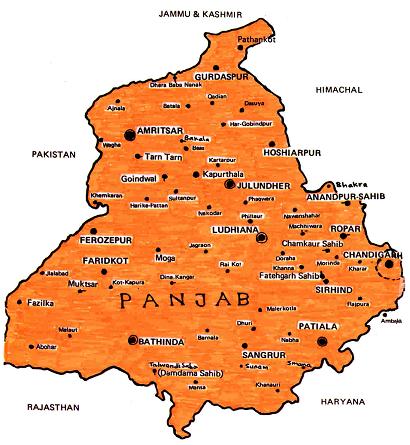
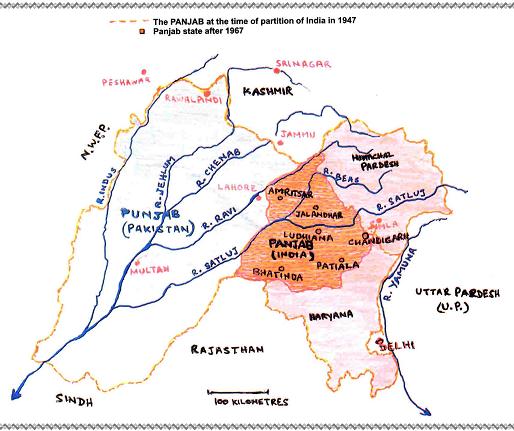
Although the Sikhs constitute about 60% of the population of the state of Panjab, their share of the total population of India is less than 2%. However, their influence has been felt rather strongly in many aspects of Indian life, with some outstanding contributions, as in:
FARMING
The majority of the Sikhs belong to farming communities in Panjab. Because of their enterprising nature, the state of Panjab leads the rest of India in the use of modern techniques in farming and farm machinery, introduced through a sustained initiative popularly known as the Green Revolution in the seventies. Sikh farmers are highly efficient, wherever they are, and have produced record yields of the crops they grow such as wheat, sugarcane, rice and cotton.
THE ARMED FORCES
The Sikhs are renowned for their martial spirit. Ever since the birth of Khalsa (the Sikh nation) they had to fight for their survival from the Mughals on one side, and the Afghans on the other. Their martial tradition was very well recognised by the British during the first and second World Wars, when there was hardly a Sikh family in the Panjab whose son or other male relative had not joined the forces. No wonder that among the Indians, the highest number of battle honours like V.C.’s were awarded to the Sikhs. Since the independence of India in 1947, this pattern of bravery has been repeated again and again during the wars with Pakistan and China.
TRANSPORT & INDUSTRY
Throughout Northern India and in larger cities like Calcutta, Delhi and Mumbai (Bombay), the Road Transport Industry seems to be dominated by the Sikhs, many of whom own fleets of trucks and taxis. In line with their spirit of adventure and hard work, they have also acquired many professional skills and taken up challenging jobs. Sikhs have earned a reputation as a skilled work force in the Indian Iron & Steel, and Machine Tool Industries as well.
EDUCATION & SPORTS
In the field of education, the Panjab state of India was not among leaders in the past, but there are now many Universities in towns like Amritsar, Ludhiana, Jalandhar, Patiala, Chandigarh etc. Education is now free and compulsory up to the age of 14, and it is accessible to every village in the Panjab. Today, wherever in the world there is a strong Sikh community, there is no shortage of Sikh doctors, engineers and lawyers.
The Sikhs also love sports and other physical activities. Kabaddi, hockey, wrestling and athletics are their favourite, in which they excel. Sikh sportsmen like Balbir Singh (hockey), Milkha Singh (athletics) Dara Singh (wrestling) and Bishan Singh Bedi (cricket) were not only heroes of millions in India, but were also well known in the sporting world abroad.
POLITICAL FREEDOM
Another of the important characteristics of the Sikhs is their firm belief in individual freedom and equality of treatment, irrespective of race or religion or gender. They do not hesitate to challenge any authority, which denies basic human rights to an individual or community. In a way, the Sikh faith was born out of the political and religious inequalities and excesses of the ruling Muslims on one hand, and the Brahaminical Hindus on the other. Indeed, Guru Nanak, the founder of the Sikh faith had himself set the pace for freedom and justice by raising his voice against the contemporary political and social situation in India. He protested publicly against the terror and bloodshed let loose by the invading army of Babar (later to be the first Mughal Emperor) for which he was charged and imprisoned with hard labour. It was for the same reason, i.e. freedom and equality, that the tenth Guru, Gobind Singh, lost his father, his mother and his sons.
During the INDIAN INDEPENDENCE MOVEMENT Sikh activists were constantly at odds with the British Raj authorities as they often spearheaded the struggle for freedom led by Mahatma Gandhi. For example,
of the 121 Indian freedom fighters who were hanged for their anti-raj activities, 93 were Sikhs;
of the 2644 Indians who were given life imprisonment for their anti-raj actions 2147 were Sikhs;
of the 1302 who died as a result of General Dyer’s ‘shoot to kill’ orders 799 were Sikhs. (This massacre happened on the Vaisakhi day of 13th April 1919 at Jallian Wala Baag in Amritsar.)
Similarly, of the POST INDEPENDENCE EVENTS, when in 1976, the then Prime Minister of India, Mrs Indira Gandhi, dissolved the democratically-elected parliament and assumed autocratic powers by declaring a state of emergency for the country, the Sikhs from Panjab proved to be the most noticeable of the opponents of this move which threatened the freedom of the Indian people. They continued their voluntary arrests in hundreds each week, protesting publicly and peacefully, until democracy was restored in 1978.
Unfortunately, in 1984 the Sikhs had to pay dearly for their political opposition to the Delhi Government, especially due to Mrs Gandhi’s dislike for the Akali’s (a religio-political party of the Sikhs). The desecration and destruction of the Golden Temple complex and about forty other Gurdwaras in Panjab by the Indian Army proved to be an unforgivable crime by her. The resultant assassination of Mrs Indira Gandhi, and in turn, the senseless and planned slaughter of thousands of innocent Sikhs in Delhi and in many other provincial towns in India led to the Sikh demand for a secure homeland in the form of an autonomous state of Panjab.
Indeed, ever since the independence of India in 1947, Sikhs have dominated the political scene in Panjab and have remained at the forefront of any political struggle to safeguard the democratic rights of the Indian people as a whole. One needs to understand that because of their past history and record of valour in war, the Sikhs are often described as a martial race. This does not mean that the Sikhs are prone to violence. Resort to arms is approved only as a last resort in self- defence and to uphold righteousness. Guru Gobind Singh put it in these words-
“When all other means of righting evil fail, it is legitimate to use the sword”.
This thinking is very close to the United Nations’ Universal Declaration on Human Rights -
“WHEREAS IT IS ESSENTIAL IF MAN IS NOT TO BE COMPELLED TO HAVE RECOURSE,
AS A LAST RESORT, TO REBELLION AGAINST TYRANNY AND OPPRESSION, THAT
HUMAN RIGHTS SHOULD BE PROTECTED BY THE RULE OF LAW”.
There are about 20 million Sikhs in the world; at least 12 million live in the Panjab, the rest are well dispersed in other states of India and a number of countries abroad. Sikhs are a progressive and forward-looking people. They are receptive to new ideas and are inspired by a spirit of adventure. They have a firm conviction that they can prosper any where in the world by hard work and faith in the Guru’s teachings. In the early part of the 20th century, this sense of self-confidence and self-reliance led them to venture abroad to Malaysia, Singapore, Thailand, Hong Kong, Philippines, East Africa and British Columbia in Canada. After the Second World War, especially in the 2nd half of the 20th century increasing numbers of them have settled in Western Europe and North America, and more recently in Australia. Today, there are about half a million Sikhs in Western Europe and a similar number in North America, the majority being in Britain (the South-east and the Midlands), Canada (BC and Ontario).
The degree of their resourcefulness and success may be seen in terms of their participation and contribution in the political and cultural life of the adopted country. Whether in the field of business or professions, Sikhs have not been found wanting. Today, Panjabi Bhangra music and Panjabi Tandoori food is as common a feature of these countries as are Sikh doctors and Sikh engineers. During the last decade, in Britain alone, at least twenty Sikh individuals can claim to have reached to the most honoured position of being the first citizen of a particular town by being elected to the office of a mayor for a term. Also, today there are 2 Sikh members in each of the Houses of Parliament. Overall position of Sikhs in Canada is even better, where they have been able to achieve ministerial positions in the provincial and national governments.
World map
The Sikh Diaspora
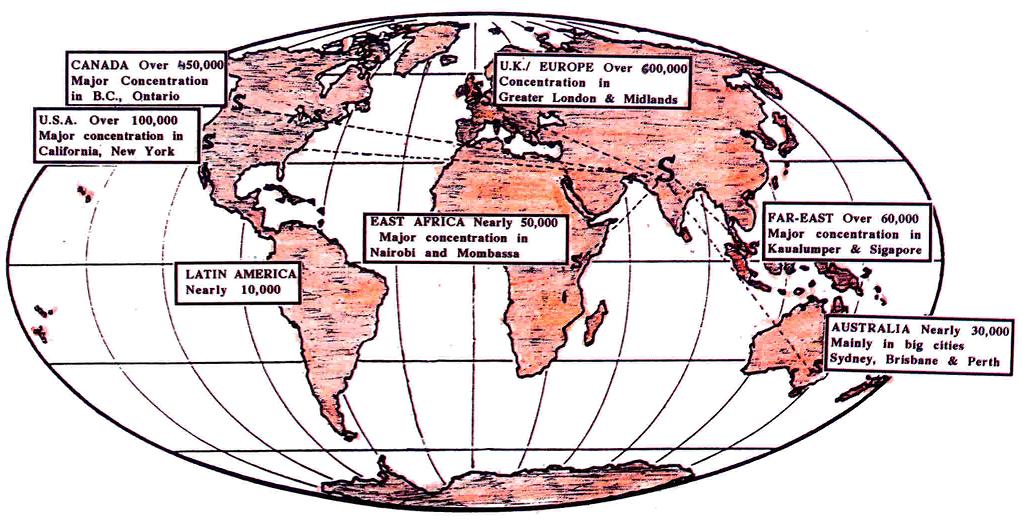
|
Sikhs constitute only
about 2% of the population of India, yet in their home state of Panjab
they are in a majority of about 60%. Other states with some significant
Sikh population are (Approximately rounded figures in 2000): |
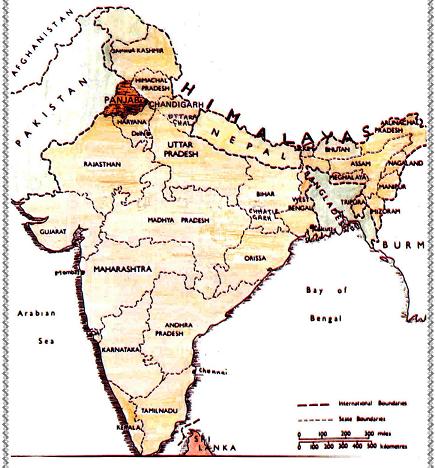 |
|
Sikhs are renowned for their warm hospitality, and for their spirit of sharing, service and sacrifice. They firmly believe in the principle of co-existence, i.e. live and let live. They make good neighbours wherever they live. Some of their social characteristics may be summed up as follows:
Attitude towards Caste
Sikhism forbids them to believe in the caste system. However, not all Sikhs have been able to dissociate themselves fully from this practice, which is the legacy of Hinduism. Again, although many Sikhs still regard themselves as belonging to certain groups or castes, such as Aroras, Bhataras, Jats, Khataris, Ramgharias, Sainis etc, these divisions should not be seen as divisions representing higher or lower castes. Fortunately, young Sikhs question the caste divisions, which are clearly against the Gurus’ teaching.
Attitude towards Sects
The Sikh Gurus strongly rejected any groupism or jingoism among their followers. However, five hundred years after the birth of Sikhism, interpretations of Sikh ideals have undergone change. We need to remember that just as in almost every major religion, there exist certain groups or sects which seem to be practising or preaching slightly differently from the ‘main body’, similarly such groups have also emerged in the Sikh community, although, their numbers are not significant, e.g. Narankaris and Namdharis.
Attitude towards Marriage
The Sikh religion does not believe in celibacy. The Sikh Gurus regarded marriage as an important and essential step towards a natural and normal life. Although divorce is not recommended in the Sikh faith, yet Sikhs do abide by the lawful proceedings where it becomes a necessity. Similarly, the Sikh faith does not stop a widow or widower from re-marrying; but rather encourages it.
Sikhs usually marry within their own religion, but allowances are made when a partner from an outside faith shows interest and willingness to accept the Sikh religion. Similarly, there are examples when a boy or a girl has not felt obliged to follow the Sikh way of marrying within the faith community. However, such cases are very few and reflect a trend, which is usually disapproved by their parents and relatives.
Attitude towards Women
The Guru’s instructions are: other than one’s own wife, a women stranger is to be regarded as a mother, a sister, or a daughter depending upon her age. In the Sikh faith a woman deserves more respect because she has ‘given birth to man.’ Sikh women enjoy a much greater degree of equality of opportunity in all spheres of life than their counterparts in many other communities. For example, Sikh women can often be seen reading and reciting the holy scriptures to the congregation in the Gurdwara, or taking an active and sometimes leading role on occasions such as political conferences, protest marches and rallies in support of their community.
Interestingly, no ARDAS (Sikh congregational prayer) is complete without remembering the extraordinary role of Sikh women in terms of their sufferings and sacrifices in the making of Sikh history.
Attitude towards people of Other Faiths.
The Guru asked Sikhs to ‘respect the Saints of every faith, put away thy pride.’ Strangers and members of other faiths are always welcome to visit a Gurdwara as long as they observe some simple rules, for example removing ones shoes and covering ones head before entering the prayer hall and the Langar (hall where food is served). Similarly, tobacco and alcohol are strictly forbidden inside the Gurdwara premises.
Again, most Sikhs would not be very happy if a visitor started smoking inside their house - although they may give a totally opposite impression, out of hospitality, by being courteous to the innocent offender. Although forbidden in Sikh scriptures, not every Sikh has been successful in resisting western influence in the use of alcohol at some public or private gatherings.
Attitude towards World Peace
Sikhism is not only the youngest of the major world religions but, perhaps, also the most misunderstood or least known, as far as its contribution in the past, and what its history and teachings can offer mankind in the future. One particular example of this ignorance is the wrongful image of the Sikhs created due to their martial attitude and appearance. Hardly any body outside the Sikh community knows that Baba Ram Singh was indeed the forerunner of Mahatma Gandhi in promoting and practising peaceful protest against the British Raj. The Sikh attitude towards peace, therefore, may be summed up in the words of the 9th Guru Tegh Bahadur:
‘‘ਭੈ ਕਾਹੂ ਕਉ ਦੇਤ ਨਹਿ, ਨਹਿ ਭੈ ਮਾਨਤ ਆਨ ।
ਕਹੁ ਨਾਨਕ ਸੁਨੁ ਰੇ ਮਨਾ ਗਿਆਨੀ ਤਾਹਿ ਬਿਖਾਨ ॥’’
“one who frightens no one, nor fears any O’Nanak
such a person is an enlightened one” (SGGS1427)
This is almost the same, as the motto of ‘live and let live’ or ‘fear not, frighten not’; and is based on the belief and respect for Basic Human Rights. This belief, which is deeply rooted in Sikhism, was re-enforced by Guru Gobind Singh in the following words: -
‘‘ਮਾਨਸ ਕੀ ਜਾਤ ਸਬੈ ਏਕੈ ਪਹਿਚਾਨਬੋ’’
‘Recognise Ye the whole human race is one’
Not only in belief, but also in practical terms the Sikh Gurus demonstrated and ensured that their Sikhs stood firm to protect this principle even at the cost of their lives. For example when the over zealous officials of the Mughal Emperor Aurangzeb of Delhi were persecuting and proselytising the Hindus in Kashmir, the Sikh Guru Teg Bahadur chose to take a stand to defend the religious freedom of the people whose Brahminical rituals he himself did not share or condone. The Guru’s protestations against religious persecutions of the Hindus and his firm stand for toleration and peace cost him his life, as he was publicly beheaded, on the Emperor’s orders, in the city square of Chandni Chowk in Delhi on 11th November 1675.
However, when the pleadings and peaceful protestations failed to put an end to the tyranny under Emperor Aurangzeb, Guru Gobind Singh responded courageously by appealing to the conscience of the people to take up arms to uphold the rights of the weak and oppressed.
That was the year 1699. More than 300 years on a roughly similar situation took place in the so called civilised world in places such as Cosovo and East Timor. Whatever the politics of the governments of different countries of the world, a Sikh can understand and appreciate the stand taken by the United Nations, approving as a last resort and allowing international military action against the forces of tyranny and oppression.
To sum up, it is regarded as the moral duty of every Sikh (Khalsa) to stand up and oppose the forces of tyranny, oppression and injustice, more so if carried out because of one’s religious belief. In Sikhism, the concept of an ideal Sikh or a Khalsa is not that of a saint but a ‘saint-soldier’. The saintly nature incorporates the traditional moral values of religion and inherently represents a peace loving individual, whilst the soldier aspect demonstrates the resolve to uphold the social values of equality, justice and freedom, which are essential for a whole community and the whole world to exist in peace.
Attitude towards Cloning*
The emphasis of Sikh teachings is not in the laying down of highly precise and rigid rules of how people might utilise God’s given knowledge. The essence of Sikh teachings is to provide people with a healthy, progressive and responsible philosophy for addressing modern issues. It provides a framework and not definitive answers for the future. Decisions regarding scientific issues should be made intelligently and ethically in any given situation.
Cloning or asexual reproduction is regarded as interference in the creative work of God and would not be sanctioned by the Sikh ideology that human life is sacred and provides an opportunity to progress to higher spiritual goals. The institution of marriage between a loving and caring husband and wife relationship is central to family life. This is the main plank for spiritual progress in Sikhism and as such children should be conceived only through this relationship. Cloning detracts from the sanctity of life and is not conducive to a healthy and natural family life.
*By courtesy of Sikh Missionary Society U.K. 23.1.2001
| Table of Contents |
Next Chapter - Chapter 2 : The Founder of the Sikh Faith
|